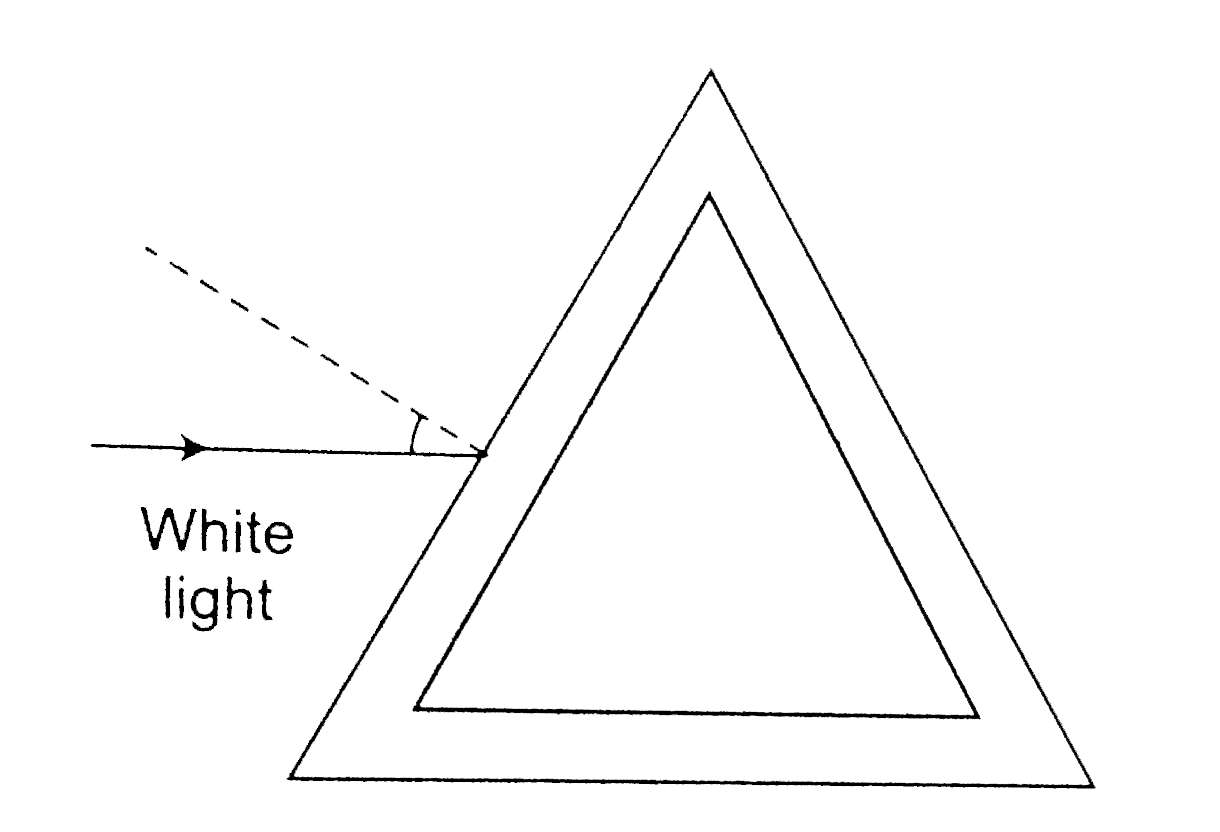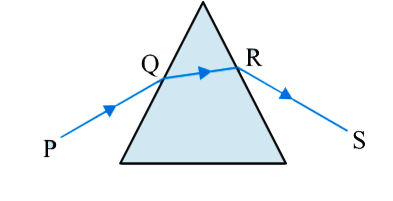STATEMENT-1 Hollow prism forms no spectra as a solid equilateral prism of glass.
STATEMENT2 Neglecting the thickness of hollow glass surface.The media is same .So dispersion is not to take place.
Statement-I is true , Statement -II is true, Statement-II is correct explanation for Statement-I.
Statement - I is true, Statement -II is true: Statement -II is NOT a correct explanation for statement -I .
Statement-I is true, Statement-II is false.
statement-I is false, statement- II is true.
The correct Answer is:A
To analyze the statements given in the question regarding the hollow prism and its ability to form spectra, we can break down the reasoning step by step.
1. Understanding the Hollow Prism:
- A hollow prism is essentially a prism that has an empty space inside it, typically filled with air. In this case, we are considering a hollow prism made of glass, where both the inside and outside of the prism are air.
2. Light Incident on the Prism:
- When light enters the hollow prism, it first encounters the surface of the prism. Since the medium outside (air) and the medium inside (also air) are the same, the behavior of light will be similar to that of a flat surface rather than a prism.
3. Refraction in a Hollow Prism:
- In a solid prism, light refracts at the boundaries due to the change in medium (air to glass). However, in a hollow prism, since both sides are air, the light will not experience a significant change in speed or direction. The light will only be slightly refracted at the surface, but this refraction is minimal due to the negligible thickness of the hollow prism.
4. Dispersion of Light:
- Dispersion occurs when light passes through a medium that has different refractive indices for different wavelengths (colors). In a solid glass prism, different colors of light are refracted by different amounts because glass has a varying refractive index for different wavelengths. In contrast, in the hollow prism, since both the inside and outside are air, there is no dispersion.
5. Conclusion:
- Therefore, the hollow prism does not form a spectrum like a solid glass prism does. The assertion that a hollow prism forms no spectra is true. The reason provided, which states that neglecting the thickness of the hollow glass surface means the media is the same and thus dispersion does not take place, is also true.
6. Final Evaluation:
- Both the assertion and the reason are true, and the reason correctly explains the assertion.
Final Answer:
- Assertion: True - A hollow prism forms no spectra as a solid equilateral prism of glass.
- Reason: True - Neglecting the thickness of the hollow glass surface, the media is the same, so dispersion does not take place.
- A hollow prism is essentially a prism that has an empty space inside it, typically filled with air. In this case, we are considering a hollow prism made of glass, where both the inside and outside of the prism are air.
- When light enters the hollow prism, it first encounters the surface of the prism. Since the medium outside (air) and the medium inside (also air) are the same, the behavior of light will be similar to that of a flat surface rather than a prism.
- In a solid prism, light refracts at the boundaries due to the change in medium (air to glass). However, in a hollow prism, since both sides are air, the light will not experience a significant change in speed or direction. The light will only be slightly refracted at the surface, but this refraction is minimal due to the negligible thickness of the hollow prism.
- Dispersion occurs when light passes through a medium that has different refractive indices for different wavelengths (colors). In a solid glass prism, different colors of light are refracted by different amounts because glass has a varying refractive index for different wavelengths. In contrast, in the hollow prism, since both the inside and outside are air, there is no dispersion.
- Therefore, the hollow prism does not form a spectrum like a solid glass prism does. The assertion that a hollow prism forms no spectra is true. The reason provided, which states that neglecting the thickness of the hollow glass surface means the media is the same and thus dispersion does not take place, is also true.
- Both the assertion and the reason are true, and the reason correctly explains the assertion.
- Assertion: True - A hollow prism forms no spectra as a solid equilateral prism of glass.
- Reason: True - Neglecting the thickness of the hollow glass surface, the media is the same, so dispersion does not take place.
Topper's Solved these Questions
- GEOMETRICAL OPTICSBOOK - ALLENCHAPTER - GEOMETRICAL OPTICSEXERCISE - Comprehension Based Questions
66 Videos
- GEOMETRICAL OPTICSBOOK - ALLENCHAPTER - GEOMETRICAL OPTICSEXERCISE - EXERCISE - 04 (A)
47 Videos
- GEOMETRICAL OPTICSBOOK - ALLENCHAPTER - GEOMETRICAL OPTICSEXERCISE - EXERCISE -03
10 Videos
- CURRENT ELECTRICITYBOOK - ALLENCHAPTER - CURRENT ELECTRICITYEXERCISE - EX.II
66 Videos
- GRAVITATIONBOOK - ALLENCHAPTER - GRAVITATIONEXERCISE - EXERCISE 4
9 Videos
Similar Questions
A beam of white light is incident on a hollow prism of glass. Then

View SolutionA light ray is normally incident onone face of equilateral glass prism of refractive index √2. The deviation of light ray is
View SolutionA solid sphere and a hollow sphere are heated the same temperature . Point out the true statement.
View SolutionSTATEMENT-1 : Inside an isolated hollow spherical shell of charge, electrostatic potential is constant everywhere
and
STATEMENT-2 : Electric field inside a hollow spherical shell of charge is always zero.
View SolutionStatement 1: If two prisms of small apex angles are made of same material then prism of larger apex angle will produce more dispersion. Statement 2: Dispersive power of a prism is proportional to apex angle of prism.
View SolutionA ray of light is incident on an equilateral glass prism placed on a horizontal table. For minimum deviation which of the following is true:

View SolutionA thin prism having refracting angle 10∘ is made of glass of refracting index 1.42. This prism is combined with another thin prism of glass of refractive index 1.7. This combination produces dispersion without deviation. The refracting angle of second prism should be :
View SolutionSTATEMENT - 1 : The white light incident on a prism, after emerging from the prism will form a spectrum of rays.
and
STATEMENT - 2 : For different colours, a prism has different refractive indices.
View SolutionSTATEMENT-1: Time period of a simple pendulum changes when the solid bob is replaced by a hollow sphere of same radius but difference mass
and
STATEMENT-2 : The time period of a simple pendulum depends on force acting on bob per unit mass dueto the earth.
View SolutionA thin prism of angle 6∘ made up of glass of refractive index 1.5 is combined with anorher prism made up of glass of refractive index 1.75 to produce dispersion without deviation. The angle of second prism is
View Solution
